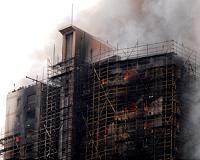| . |  |
. |
West Lafayette IN (SPX) Nov 22, 2010 Researchers at Purdue University are studying the effects of fire on steel structures, such as buildings and bridges, using a one-of-a-kind heating system and a specialized laboratory for testing large beams and other components. Building fires may reach temperatures of 1,000 degrees Celsius, or more than 1,800 degrees Fahrenheit, said Amit Varma, a Purdue associate professor of civil engineering who is leading the work. "At that temperature, exposed steel would take about 25 minutes to lose about 60 percent of its strength and stiffness," he said. "As you keep increasing the temperature of the steel, it becomes softer and weaker." One project focuses on how a building's steel-and-concrete floor and its connections to the building behave in a fire. Another project concentrates on how fire affects steel columns and a building's frame. Such testing is customarily conducted inside large furnaces. "However, in a furnace it is very difficult to heat a specimen while simultaneously applying loads onto the structure to simulate the forces exerted during a building's everyday use," Varma said. To overcome this limitation, Purdue researchers designed a system made up of heating panels to simulate fire. The panels have electrical coils, like giant toaster ovens, and are placed close to the surface of the specimens. As the system is used to simulate fire, test structures are subjected to forces with hydraulic equipment. In practice, beams and other steel components in buildings are covered with fireproofing materials to resist the effects of extreme heating. "Because the steel in buildings is coated with a fireproofing material, the air might be at 1,000 degrees but the steel will be at 300 or 400 degrees," Varma said. "We conduct tests with and without fire protection." The work is funded by the National Science Foundation and the U.S. Department of Commerce's National Institute of Standards and Technology. The heating system is being used to test full-scale steel columns at Purdue's Robert L. and Terry L. Bowen Laboratory for Large-Scale Civil Engineering Research. It is believed to be the only such heating system in the world, Varma said. Each panel is about 4 feet square, and the system contains 25 panels that cover 100 square feet. Having separate panels enables researchers to heat certain portions of specimens, recreating "the heating and cooling path of a fire event," Varma said. The Bowen Lab is one of a handful of facilities where testing can be performed on full-scale structures to yield more accurate data. The 66,000-square-foot laboratory is equipped with special hydraulic testing equipment and powerful overhead cranes. The research group also has tested 10-foot-by-10-foot "composite floor systems" - made of steel beams supporting a concrete slab - inside a furnace operated by Michigan State University. The composite design is the most common type of floor system used in steel structures. Findings from that research will be compared with floor-system testing to be conducted at the Bowen Lab. Results from both experiments will be used to test and verify computational models used to design buildings. "Most of these experiments are showing that we have good models, and we are using data to benchmark the models and make sure the theory and experiment agree with each other," Varma said. Models are needed to design composite floor systems, which can be heavily damaged by fire. "When you have a floor supporting weight, the floor starts sagging from the heat," Varma said. "It expands, but it's got nowhere to go so it starts bowing down, which produces pulling forces on the building's frame. It starts pulling on the columns and then it becomes longer and permanently deformed. After the fire, it starts cooling, and then it starts pulling on the columns even harder."
Share This Article With Planet Earth
Related Links Purdue University Forest and Wild Fires - News, Science and Technology
 China orders fire-safety push after deadly Shanghai blaze
China orders fire-safety push after deadly Shanghai blazeShanghai (AFP) Nov 17, 2010 China has ordered a nationwide overhaul of fire-control measures after a blaze at a Shanghai high-rise killed 53 people and highlighted the country's chronic problem with lax safety enforcement. The inferno in the 28-storey apartment block on Monday caused panicked residents to attempt desperate jumps to safety or seek refuge on rickety construction scaffolding surrounding the building, whic ... read more |
|
| The content herein, unless otherwise known to be public domain, are Copyright 1995-2010 - SpaceDaily. AFP and UPI Wire Stories are copyright Agence France-Presse and United Press International. ESA Portal Reports are copyright European Space Agency. All NASA sourced material is public domain. Additional copyrights may apply in whole or part to other bona fide parties. Advertising does not imply endorsement,agreement or approval of any opinions, statements or information provided by SpaceDaily on any Web page published or hosted by SpaceDaily. Privacy Statement |